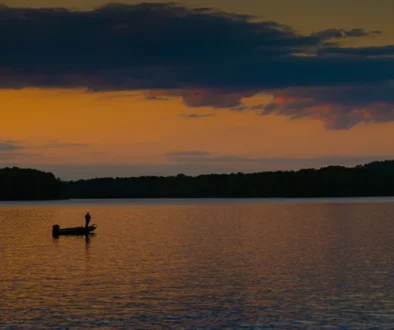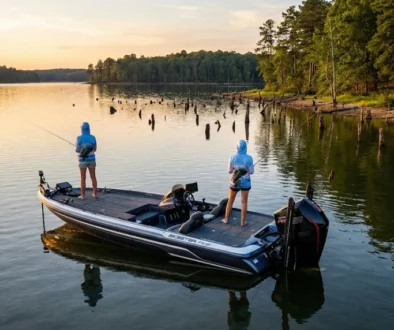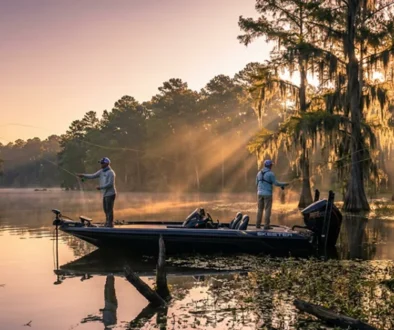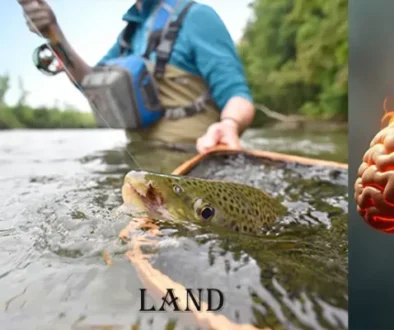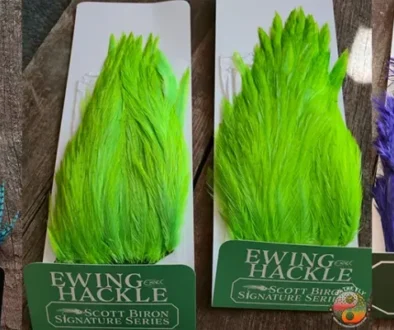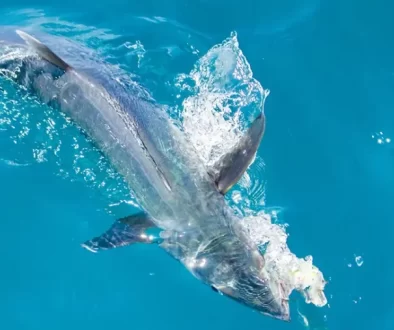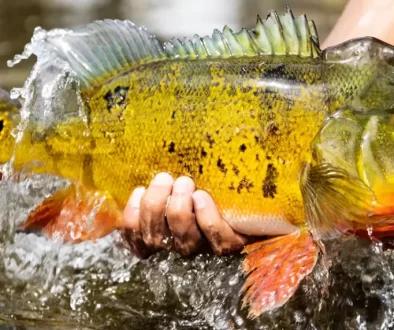Table of Contents
How to Start Fly Fishing for Muskie: A Beginner’s Guide
By Craig Lamb
Ever cast a line into the shimmering water, feeling your heart pound as you anticipate that tug on your fly? It’s like waiting for a blind date to walk through the door. Fly fishing for muskie is much more than just another pastime—it’s an adrenaline-fueled dance with one of nature’s most elusive and ferocious predators. As you learn How to Start Fly Fishing for Muskie.
Muskie—also known as ‘the fish of ten thousand casts’—are not easy prey. But who can resist a good test?
In this guide, we’ll unravel their mysteries: Where do they lurk in still lakes or swift rivers? What techniques will make them strike at your fly? How can you perfect the art of working your fly and use the figure-eight method effectively?
We’ve got tips and tricks aplenty coming up! So, ready to step up from trout to learning how to start fly fishing for muskie?
The Rising Popularity of Fly Fishing for Muskie
It’s no secret that fly fishing for muskie is on the rise. This elusive fish, known as the ‘Fish of Ten Thousand Casts’, has become a sought-after prize among anglers. The allure? Well, it’s simple: Muskies are hard to catch. This is an important fact as you Learn how to start Fly Fishing for Muskie.
Why do people willingly spend hours in pursuit of this one fish species? Is it their aggressive strikes or their tenacious fights once hooked?
You bet. But more than that, these freshwater beasts present an angling challenge like no other – they’re unpredictable and notorious for being selective eaters which makes them even harder to hook.
Even Montana Offers Monster Tiger Muskie on Fly Rod
Place like Ackley Lake in central Montana gives you the opportunity of catching a fifty inch plus Muskie.
The Allure: It’s More Than Just Casting A Line
Fly fishing involves much more than just casting a line into water; there’s an artistry and rhythm involved that draws many to its calming effect. Muskie hunting, with its mix of patience-testing stealthiness and adrenaline-pumping action moments, fits perfectly within this narrative.
This thrill isn’t solely about catching big fish – though don’t get us wrong; reeling in a massive muskellunge can indeed make your heart pound like a drum.
Growth Stats: A Look at Numbers Behind The Trend
- Muskie populations have seen growth over recent years due largely in part to careful conservation efforts from groups such as Muskies Inc., leading more anglers onto the hunt.
- Fishing equipment manufacturers have also recognized this growing interest by producing gear specifically tailored towards muskellunge hunters – think specialized fly rods, heavy duty lines and large, colorful flies.
- Online platforms have played a significant role too. From forums where seasoned anglers share their muskie tales and advice to YouTube channels offering tutorials on how to tie the perfect muskie fly – it’s easier than ever for newcomers to the sport of fly fishing for muskie’s to join in.
The growth of this niche is not just speculation; the numbers back it up. In fact, a recent study showed that Musky fishing has seen an increase of approximately 20% over the past five years.
Understanding Muskie Behavior in Different Waters
Muskies are a fascinating species. Like undercover agents, they blend into their environment and wait for the right moment to strike. But here’s the thing: their behavior changes based on where you find them – still waters or moving waters.
The Habits of Muskie in Moving Waters
Rivers and streams are like highways for muskies, but with one difference – traffic rules. Just as drivers prefer certain lanes, muskies have favorite spots too. They often behave similarly to trout by staging in eddy water (a circular current) where they can ambush food effortlessly. NOAA Fisheries provides an insightful guide on this behavior.
This is akin to sitting at a cafe sipping your coffee while someone serves up pastries; who wouldn’t love that? Well, our friends from underwater do just that. Understanding these habits will let you know exactly where to cast your fly when fishing in rivers and streams.
The Habits of Muskie in Still Waters
In lakes though, it’s more about location scouting than highway cruising for muskies. You’ll often find them lurking around deeper holes, drop-offs or shoals readying themselves for an attack.
If we compare it again with humans (because why not?), imagine yourself shopping during sales season; you’ll try every aisle until you hit jackpot right? That’s what muskies do- check all possible places before settling down. NOAA Fisheries offers more detailed insights on this.
It’s all about knowing the rules of their game to outsmart these clever creatures. And let me tell you, it’s worth every bit of effort when that line finally tugs.
The Art of Working a Fly for Muskie
When you’re out on the water, targeting that elusive muskie with your fly rod, it’s all about mastering three key variables: strip speed, pause length, and number of strips. This trifecta is what makes or breaks your game.
Mastering the Strip Speed
Muskie are smart fish; they aren’t easily fooled by artificial flies. You’ve got to convince them that your fly is worth their energy expenditure. To do this effectively when fly fishing for muskie, varying your strip speed can be crucial.
A consistent pace? That’s going to make any wary predator suspicious. A stop-and-go rhythm mimics an injured baitfish far better and has more chance of attracting attention from our toothy friends in the deep blue waters.
Understanding Pause Length
Pause length isn’t just about taking a break; it’s part of the dance – yes folks, I said ‘dance’. The erratic motion of pausing while stripping imitates prey behaviour accurately and could mean bagging yourself one helluva trophy catch.
If you’re consistently not getting bites even though there are active feeders around (we’ve all been there), try playing around with pause lengths between strips—shorter pauses might entice hesitant biters into action.
The Importance of Number Of Strips
Fly fishing aficionados will tell you that variation keeps things interesting—for both anglers and fish alike. When it comes to catching those hard-fighting muskies on a fly rod though, mixing up the number of strips you make before pausing can be a game-changer.
Keeping it unpredictable with your strip count is another way to mimic wounded baitfish, which makes for an irresistible meal to any nearby muskie. They’re smart creatures, but they can’t resist a struggling snack.
Working a fly for muskie requires constant erratic motion with a constantly changing strip speed, pause length, and number of strips. But remember folks: every day on the water is different—stay flexible in your approach and let those lunkers show you what works best.
The Figure-Eight Method for Muskie
If you’ve spent time chasing muskies, then you know they’re a tough catch. They don’t call them the fish of ten thousand casts for nothing. But there’s one method that has proven to work wonders: The figure-eight.
Now, this isn’t your typical cast and retrieve game; it’s more like an underwater dance with a rod in hand. Let me explain it in detail.
Understanding the Figure-Eight Method
This tactic is actually borrowed from conventional tackle fishing and adapted into fly fishing to entice these toothy predators. The idea here is simple: when your fly reaches the boat after retrieving, instead of lifting out for another cast immediately, make sure to continue moving your fly in an ‘eight’ pattern at close range near or under the boat before recasting again. More on figure-eight technique can be found here.
You see, Muskies are notorious followers – often trailing bait right up to the angler’s feet without committing to strike. So this action can mimic a panicked prey trying to escape which triggers their predatory instinct.
Tips on Performing an Effective Figure-Eight
Performing a successful figure eight starts by keeping that line tight as hell against your rod tip – because slack means no hook set if a Muskie decides he wants dinner after all. Remember: tension equals control.
- Your movements should also be wide enough (around 4ft diameter) so as not scare off our finned friend yet sudden enough appear erratic.
- The depth should vary too – sometimes at the surface, sometimes a foot or two down.
- Keep your eyes peeled for followers so you can react immediately if they decide to strike. It’ll be a pulse-pounding instant.
The key is unpredictability – mix things up and keep them guessing.
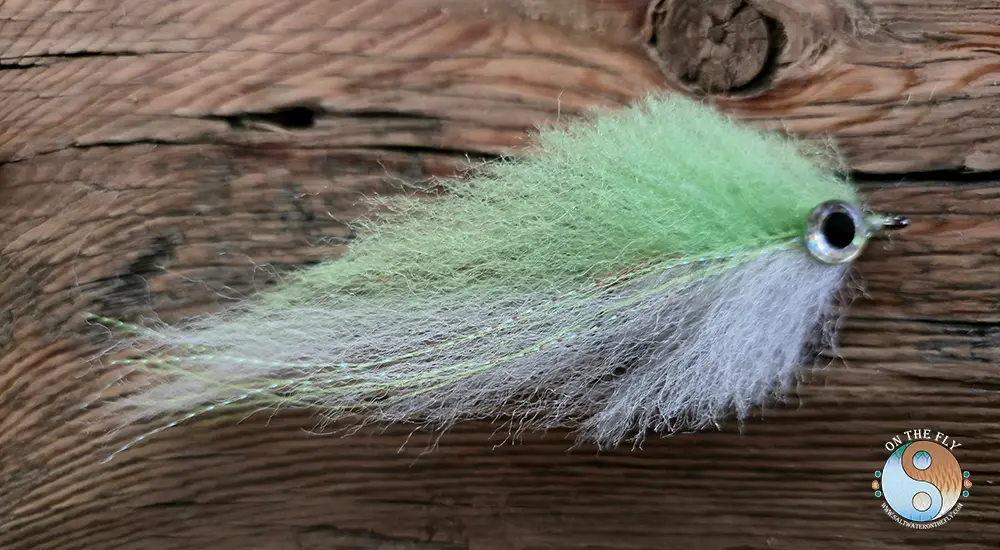
Chartreuse-White Pelagic Forger Minnow
Fly Fishing Pelagic Forger Minnow for Musky: Tying Guide
Chasing musky on the fly is a special kind of pursuit, isn’t it? It’s a challenge that grabs you and doesn’t let go. You’ll need patience, a bit of luck, and absolutely the right fly. For serious anglers, Fly Fishing a EP Brush Minnow and for Musky with tying instructions using Semperfli Predator Fibres Eye 3D Halo Eyes On a Partridge Saltwater Hook is a setup that often brings results. This isn’t just another fly; it’s a carefully constructed predator magnet, far different from delicate trout tying materials used for a light cahill.
The EP Brush Minnow, especially in those eye-popping color combinations, is built to mimic what musky love to eat, like distressed baitfish or even small mangrove baitfish in other ecosystems. Its construction makes it almost irresistible to these freshwater giants. You’ll learn how effective Fly Fishing a EP Brush Minnow and for Musky with tying instructions using Semperfli Predator Fibres Eye 3D Halo Eyes On a Partridge Saltwater Hook can be, whether you’re on a murky river or a clear lake, environments where many retired patterns simply wouldn’t hold up. Check out the Chartreuse-White Pelagic Forger Minnow, it’s one of my favorites for musky.
Why This Fly is a Musky Magnet
Musky are apex predators in their aquatic environments. They are known for explosive, aggressive strikes, and that’s exactly what the EP Minnow plays to. The color combination isn’t random; it’s selected for maximum attraction. For example, chartreuse is fantastic for cutting through dirty water, making your fly get noticed even when visibility is poor, much like how specific colors work for a green drake hatch in trout streams.
Then you have rich purple, which really stands out in clearer water conditions. It adds a subtle contrast that can be the difference-maker when musky are wary. White and blue hints perfectly mimic the natural flash and shimmer of baitfish like shiners or even small bullfrogs, depending on how you present it; this is a world away from the subtle tones of a pale evening dun.
This mix of bright, attention-grabbing colors and natural, lifelike tones stimulates a musky’s predatory brain. It’s a pattern that has earned its stripes with anglers targeting these elusive giants, proving more effective in these scenarios than traditional patterns perhaps designed for targeting fish feeding on a march brown / gray fox hatch. Some anglers even experiment by adding sili legs for extra movement, further enhancing its appearance.
Getting to Know the Pelagic Forger Minnow’s Magic
So, what’s the big deal about the Pelagic Forger Fish? It’s a streamer fly, typically tied using synthetic tying materials like ep® fibers or Semperfli Predator Fibres. These fibers are fundamental to its success. They create a fly that looks and, more importantly, moves like a real baitfish, similar to how gamechange fibers allow for incredible articulation in other patterns.
This lifelike swimming action, often paired with realistic 3D eyes, is what seals the deal for hungry predators in all sorts of warm water conditions. The main job of this fly is to look like a small fish. That’s what big game fish, from bass and pike to our beloved musky, are hunting for, a different prey image than what a rusty spinner represents to a trout.
Because it’s made with lightweight synthetic materials like silky fibers, it “breathes” in the water. This creates a natural, enticing movement that triggers those hard-wired attack responses. This breathing action is much more pronounced than what you might achieve with a denser predator brush alone, though some tyers incorporate predator brush elements for specific profiles.
Essential Gear: Materials for Your Musky Slayer
Alright, let’s talk about what you’ll need to tie this musky-catching machine. Having the right stuff makes all the difference. You wouldn’t want a trophy fish to straighten your hook or the fly to fall apart after one cast, right? Quality components are your friends, far more robust than the delicate hooks used for a quill gordon.
Here’s a breakdown of the essentials:
| Material | Description/Recommendation | Why it’s important |
|---|---|---|
| Hook | Partridge Saltwater Hook, size 2/0 to 5/0 for musky | You need a strong, sharp hook. Partridge hooks offer excellent strength and corrosion resistance, vital for big, tough fish and varied water conditions. |
| Thread | Strong fly tying thread, like a 140-denier or even gel-spun polyethylene | This holds everything together. A robust thread prevents your hard work from unraveling mid-fight. Some might use this for trout tying larger streamers too. |
| Body Fibers | Semperfli Predator Fibres in Rich Purple and Chartreuse. Alternatively, ep® predator fibers or trigger point® fibers can be used. | These synthetic fibers are durable, don’t absorb much water (so they’re easy to cast), and give incredible movement. The chosen colors are proven musky attractors. Consider materials like ep® sparkle for added flash. |
| Belly & Accent Fibers | White and Blue Semperfli Predator Fibres. Some tyers might use ep® silky fibers for a softer look. | White creates a natural belly look. Blue adds subtle flash and imitation of baitfish gill plates or lateral lines. |
| Eyes | 3D Halo Chartreuse Eyes (around 8mm to 10mm for these hook sizes). Some tyers prefer lead eyes for added weight on certain patterns. | Eyes are a huge strike trigger. These 3D eyes add realism and a distinct aiming point for the musky. Chartreuse matches the body and offers visibility. For different prey imitations, shrimp eyes could be used on saltwater patterns like an shrimp. |
| Head Cement | Quality waterproof head cement or UV cure resin | Secures thread wraps, especially around the eyes and at the finish, making your fly much more durable. This is a standard item in most tying materials kits. |
Using Semperfli Predator Fibres is a great choice here; these point® fibers are specifically made for large predator flies. They flow naturally in the water, mimicking the movement patterns of living prey, much like well-tied Semperfli Predator fly fibers. The 3D Halo Chartreuse Eyes not only look good but act as a focal point for a musky’s attack. And that Partridge Saltwater Hook? It gives the backbone and sharpness you need when a forty-inch fish decides to bite. Some complex flies like articulated patterns rely on similar strong hook foundations.
While this pattern focuses on specific fibers, the world of synthetics is vast. Materials like gamechange fibers have revolutionized articulated streamers, and even specialized dubbings like shrimp dub or monster bush fur dub have their place for creating specific textures or bodies on other fly types, perhaps even an crab imitation which might include a crab body material.
Your Step-by-Step Tying Guide for the Musky Pelagic Forger Minnow
Ready to sit down at the vise? Tying this fly isn’t overly complicated, but attention to material placement makes a big difference. We want a fly that swims true and looks alive, a far cry from the precision needed for a tiny blue wing olive dry fly. Take your time with these steps, ensuring each material, from the Semperfli Predator Fibres to the 3D Halo Eyes, is secured on the Partridge Saltwater Hook.
Here’s how you craft the Purple-Chartreuse, White, Blue, and Bullfrog inspired EP Minnow:
-
Secure the Hook and Start the Thread: First, clamp your Partridge Saltwater Hook firmly in the vise. Start your tying thread just behind the hook eye, making a solid thread base. Wrap back towards the hook bend, stopping about halfway down the shank for now. This gives you a good foundation to build upon.
-
Prepare and Tie in the Belly (White Fibers): Take a small bunch of white Semperfli Predator Fibres. Comb them out to align the fibers and remove any very short pieces. Remember, less is often more with EP style flies for good movement. Tie these in on the underside of the hook shank, with the fibers extending past the hook bend by about 1.5 to 2 times the hook shank length. Secure them tightly with several firm wraps and trim any excess forward-facing material neatly.
-
Layer Blue Accents: Now, take an even smaller, wispy bunch of blue Semperfli Predator Fibres. This is just an accent, meant to mimic a lateral line or gill flash. Tie this bunch on top of the white, but slightly shorter. This subtle layering adds depth and a touch of realism, different from the blocky colors sometimes seen in retired patterns.
-
Advance Thread and Attach the 3D Halo Eyes: Move your thread forward to about one-third of the hook shank length back from the eye. This is where your 3D Halo Chartreuse Eyes will go. Secure one eye on your side of the hook shank using figure-eight wraps. Repeat on the other side, making sure the eyes are even and level. Add a small drop of head cement or super glue here to lock them in before proceeding; this helps prevent them from shifting.
-
Build the Main Body (Chartreuse Fibers): Take a medium bunch of Chartreuse Semperfli Predator Fibres. Tie this in on top of the hook shank, just behind the eyes. These fibers should extend back, ideally matching the length of the white belly fibers, or slightly longer, to create the main profile of your minnow. Spread the fibers around the top and sides a bit to create a rounded, baitfish-like shape.
-
Add the Purple Top Layer: Now for the final color pop. Take a slightly smaller bunch of Rich Purple Semperfli Predator Fibres. Tie this directly on top of the chartreuse layer, extending it to the same length. This creates that signature two-tone look that musky find so appealing. Think of it like the dark back of a baitfish, a common camouflage pattern in many fish species.
-
Form the Head and Finish: Carefully build a neat, tapered thread head in front of the eyes, covering any exposed material butts. Some tyers like to use a different colored thread here for a hot spot. Whip finish your thread securely. Apply a generous coat of head cement to the thread wraps, making sure to seal around the base of the eyes as well. This will greatly improve the fly’s durability, making it ready for many encounters. Let it dry completely before adding it to your fly box alongside your streamer collection.
Once you’ve tied a few, you’ll get a feel for how much material to use. You want enough point® supreme quality fibers to create a good profile, but not so much that it kills the action or makes the fly too heavy to cast comfortably with your setup. A sparsely tied EP style fly, perhaps using techniques similar to those for building an streamer brush, often has the best movement in the water.
Some tiers like to experiment with adding a small amount of Crystallized sparkle or similar flashabou type material mixed within the body layers for extra attraction. For a different approach to body construction, one could even explore using a brush or a streamer brush made from similar synthetic fibers if aiming for a denser, fuller profile. This particular Brush Minnow however, relies on the sparse tying of loose fibers for its signature action.
Text content
Mastering the Retrieve: How to Make Your Pelagic Forger Minnow Dance
Tying the fly is only half the battle, right? Now you’ve got to make it swim in a way that screams “easy meal” to a musky. The Pelagic Forger Minnow, constructed with those lively Semperfli Predator Fibres, is wonderfully versatile, but knowing a few core retrieve styles will up your game. Remember, musky fishing is often about persistence and trying different things until you find what they want that day; it’s not like waiting for a predictable brown drake emergence.
According to the Ontario Ministry of Natural Resources and Forestry, musky are ambush predators, so your retrieve should mimic prey behavior – sometimes erratic, sometimes injured. Consider using trigger point® mayfly tails on a completely different style of fly for a different species, to understand how material movement impacts presentation.
Casting Your Offering
First things first, rod selection matters, as discussed. For musky, you’re looking at a heavier setup. These rods can handle casting larger flies and fighting powerful fish species.
Where should you cast? Look for likely musky hangouts. These include undercut banks, drop-offs where shallow water meets deep, submerged logs or timber, and the edges of weed beds. Cast across the current or slightly upstream to let your fly sink naturally into the strike zone, similar to how one might present a streamer during a march brown period, but with a much larger offering.
The Art of the Retrieve
The core technique for an EP Minnow is the strip retrieve. Use short, sharp strips of your fly line, maybe 6 to 12 inches at a time. This makes the fly dart and jig, like a baitfish trying to escape, quite unlike the subtle twitches you’d give an mayfly imitation. But don’t be a one-trick pony.
- Vary Your Speed: Sometimes musky want it fast and erratic, especially in warmer water when their metabolism is high. Other times, particularly in cold water or if fish are sluggish, a slower, more methodical retrieve can work wonders, even a retrieve that mimics an crustaceous type offering crawling along the bottom if you add weight.
- The Power of the Pause: This is huge. After a strip or two, let the fly pause briefly. The synthetic fibers, like those in an thunderstruck fly, will flare, and the fly will often hover or slowly sink. This pause mimics an injured or stunned baitfish – an easy target that can trigger a reaction strike.
- Rod Tip Position: Keep your rod tip low, pointed down towards the water and at your fly. This gives you better contact with the fly, helps you detect subtle takes, and allows for a more powerful strip-set.
- The Figure-Eight: Always, always finish your retrieve with a figure-eight or L-shaped sweep of your fly at the side of the boat or bank. Many musky follow the fly right to you and will strike at the last second during this maneuver. This is where many heart-stopping moments occur.
Controlling the Depth
Getting your fly to the right depth is critical. Musky can be anywhere in the water column, from shallow weed flats to deep channel edges. Your line choice makes a big difference here, more so than when nymphing with mayfly dub patterns for trout near the surface during an evening dun event.
- Line Types: A floating line is good for shallow water or if you want to work the fly near the surface. For deeper presentations with your Pelagic Forger Brush Minnow or even an gamechanger streamer, you’ll want a sink-tip line or even a full sinking line. Sometimes, a few non-lead eyes split shot added to your leader can help get a floating line presentation down a bit, though a true sinking line is often better.
- The Countdown: After your cast, let the fly sink before you start your retrieve. Count it down – “one-thousand-one, one-thousand-two…” Experiment with different counts to find the depth where fish are holding. This is a standard tactic across many types of streamer fishing, not just for musky.
Advanced Tactics for Those Finicky Fish
Sometimes, the basics aren’t enough, especially with educated or moody musky. Here are a few more advanced techniques you can try with your Pelagic Forger Minnow. Thinking like a predator helps you present your fly more effectively, very different from the approach for matching a red quill hatch.
- The Two-Handed Retrieve: For a really active, sometimes erratic retrieve, use both hands. One hand grips the rod, the other strips the line. You can alternate quick, short strips with longer, smoother pulls to create a very lifelike, panicked baitfish action with your Semperfli Predator Fibres fly.
- Pauses and Twitches: During those pauses, add subtle twitches with your rod tip. This can make the synthetic fibers undulate seductively, giving just a bit more life to the fly without moving it forward much. This micro-movement can be deadly.
- Matching Local Forage: While not classic “hatch matching” like in trout tying for a gray fox emergence, pay attention to the local baitfish. Are they perch, suckers, ciscoes, or shad? Adjust your EP Minnow size and subtly tweak colors if needed. Sometimes a pattern like the peanut butter® gains fame because it closely mimics a key local forage.
- Swinging the Fly: If you’re fishing in river currents, try casting downstream at about a 45-degree angle. Let the fly swing across the current. You can use mends in your line to control the speed and depth, keeping it in the prime strike zone for longer.
- The All-Important Strip-Set: This is fundamental for musky. When you feel that tell-tale bump or see your line jump, resist the urge to lift your rod tip like a trout fisherman setting on a / gray fox dry fly. Instead, pull hard and sharp on the line with your stripping hand while sweeping the rod to the side. This drives that big Partridge Saltwater Hook home into a musky’s tough, bony mouth.
- Structure Focus: Pay close attention to changes in bottom contour, weed lines, submerged timber, and rock piles. Musky are ambush predators and will use structure to conceal themselves. Make repeated, accurate casts to these high-percentage spots.
Global Appeal: Where This Fly Catches Giants
The beauty of this Pelagic Forger Minnow pattern, built with rugged materials like Semperfli Predator Fibres and Partridge Saltwater Hooks, is its global applicability. It’s not just a North American secret. From the diverse waters of Canada and the USA to the pike and zander fisheries across Scandinavia and Europe, this fly performs. Its principles can even inspire patterns for other toothy fish species worldwide.
Its adaptability means you can fish it effectively in shallow, stained rivers or deep, clear lakes. Change your retrieve, change your line, and you can target musky holding in very different environments. While this specific pattern is for freshwater, the concept of using durable, mobile tying materials to mimic baitfish is universal, even extending to saltwater flies targeting species that feed on mangrove baitfish or requiring components like a crab body or realistic shrimp eyes for patterns like the crustaceous or shrimp.
Why Semperfli Predator Fibres and Partridge Hooks Shine
You might wonder if the specific brands matter. When you’re after fish that can top 50 inches and weigh over 30 pounds, yes, they do. Semperfli Predator Fibres are engineered for this kind of fishing. They shed water well, meaning your fly doesn’t become a waterlogged sponge after a few casts, making it easier to cast all day. This is a key difference from natural materials sometimes used in trout tying materials like mayfly dub which can absorb water readily.
The fibers also have a fantastic natural movement in the water, pulsating and flowing even with slight currents or subtle twitches from your rod tip; some have a silky fibers quality. Their durability is also a big plus; they can stand up to toothy critters. Materials like these, or trigger point® supreme fibers, are a far cry from the delicate mayfly tails or point® mayfly tails used for insect imitations. These predator flies are built to last, unlike some retired patterns that were perhaps too fragile.
Partridge Saltwater Hooks are renowned for their strength and sharpness. A musky’s mouth is a tough place, full of bone and teeth. You need a hook that can penetrate easily and won’t bend out during a prolonged, powerful fight. The corrosion resistance is also important, as many musky waters can have varying chemistries, and you want your hooks to last. These specific material choices contribute significantly to the success of your Fly Fishing a EP Brush Minnow and for Musky with tying instructions using Semperfli Predator Fibres Eye 3D Halo Eyes On a Partridge Saltwater Hook setup. You’re not using fine wire hooks suitable for a / gray midge here.
A Few Last Tips Before You Hit the Water
Before you head out, just a couple more thoughts. Fishing, especially for challenging species like musky, is a constant learning game. Don’t be afraid to experiment, even if it means trying a pattern named something whimsical like peanut butter® if local anglers swear by it.
Change up your retrieve speed, depth, and even subtle color variations in your flies if one thing isn’t working. Sometimes the smallest change makes the biggest difference. And always practice stealth. Approach your fishing spots quietly, and try to avoid casting your shadow over the water, especially in clearer conditions. Wary fish are hard to catch.
Finally, check your hooks regularly. Keep them sticky sharp. A file or hook hone is an essential tool. A sharp hook penetrates better and means more landed fish, especially with tough-mouthed species like musky and pike. Proper gear care, including using quality tying materials like Semperfli and robust hooks, can lead to more success. Consider also having appropriate release tools: long-nosed pliers, jaw spreaders, and a large, rubberized net to ensure the fish’s safety if you practice catch and release.
While the EP Brush Minnow is a fantastic all-around pattern, don’t shy away from exploring other styles too. Flies incorporating semperfli Predator fly fibers for building durable heads, or highly mobile articulated patterns, can also be incredibly effective. The world of predator fly tying is constantly advancing.
Hooking a Muskie: Techniques and Tips
The moment of truth in fly fishing for muskie arrives when you feel that electrifying tug on your line. You’ve fooled the fish with your carefully selected fly, but now comes the challenge of setting the hook properly.
Muskies are notorious for their tough mouths which can make securing a solid hook set quite tricky. That’s why it’s essential to use a technique called strip-strike instead of trying to set the hook by lifting your rod tip like you might do when trout fishing.
Mastering The Strip-Strike Technique
The strip-strike method, widely used among seasoned muskie anglers, requires some practice but can drastically increase your hookup rate. It involves maintaining tension while stripping line rapidly through the guides using swift, long pulls rather than short jerks or lifts of the rod tip.
This method keeps constant pressure on the fish, helping drive home those larger hooks often found on flies designed specifically for big predators like muskies.
A key part here is keeping control over slack lines because even an instant release could lead to losing these elusive giants just as they’re about to be landed.
The Right Gear Matters
You’ll need gear up accordingly if you want more success with this game. Heavy-duty rods (10-weight or higher) are preferred since they provide enough backbone needed during fight time without risking breakage from high-pressure situations usually associated with hunting monster-sized fishes such as Muskies.
Fishing reels should ideally have smooth drag systems and enough capacity to hold plenty of backing. You don’t want a muskie taking off with all your line, do you?
Also consider using sturdy wire or heavy fluorocarbon leaders as they can withstand the sharp teeth of these apex predators.
The Right Hook Set Mindset
up in the thrill of it all. Patience is essential in muskie fishing, as it aptly earns its moniker of ‘the sport of a thousand casts’. After all, they don’t call muskie fishing ‘the sport of a thousand casts’ for nothing.
FAQs in Relation to How to Start Fly Fishing for Muskie
What is the best fly line for muskie?
The ideal fly line for muskie is a fast-sinking, heavy-weight forward type. It lets you cast large flies and cope with windy conditions.
What do I need to start musky fishing?
To kick off your musky fishing journey, you’ll need a stout rod (10-12 weight), reel with good drag system, sinking fly lines, steel leaders, and big streamer flies.
What size fly rod for musky fishing?
A 9 to 11-foot rod in the 10-12 weight range works well for casting big flies when targeting Muskie. I personally use a Snowbee 10 weight saltwater fly rod for Muskie and Pike.
What month is best for muskie fishing?
Late fall months like October and November are typically prime time because Muskies feed heavily before winter sets in.
Conclusion of Learn How To Start Fly Fishing for Muskie
Starting your journey into fly fishing for muskie can feel like stepping into a new world. A world where understanding the behavior of these elusive creatures is key.
You’ve learned how muskies behave differently in moving waters and still lakes, hiding out in deep holes or lurking near vegetated shorelines.
We dove into the art of working a fly—mastering strip speed, pause length, and number of strips—and discovered the crossover tactic: The figure-eight method.
The journey continues. How to Start Fly Fishing for Muskie has only just begun with this guide!
So keep casting that line. Keep feeling your heart pound. Because every cast brings you closer to landing that mighty muskie.

